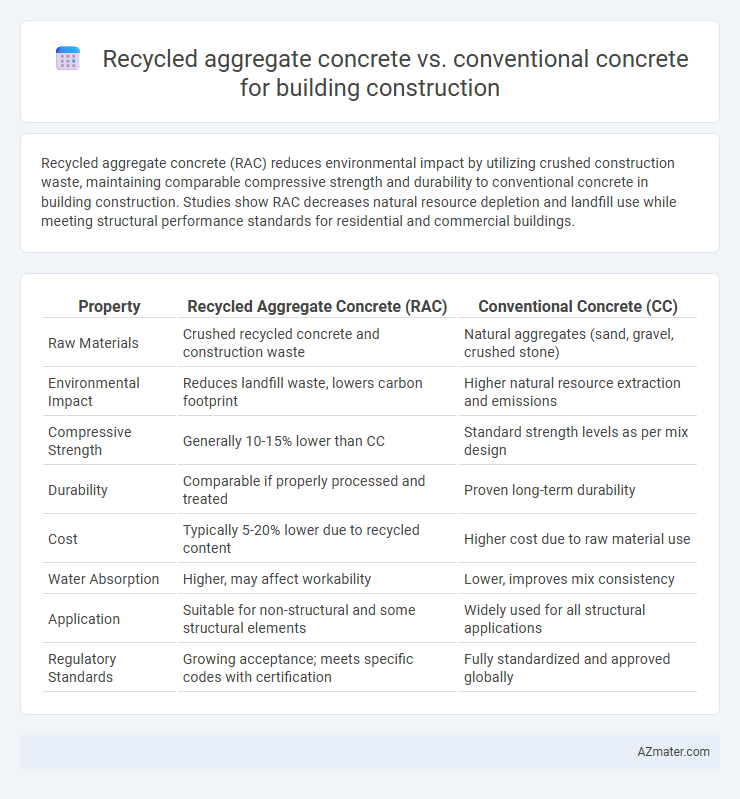Recycled aggregate concrete (RAC) reduces environmental impact by utilizing crushed construction waste, maintaining comparable compressive strength and durability to conventional concrete in building construction. Studies show RAC decreases natural resource depletion and landfill use while meeting structural performance standards for residential and commercial buildings.
Table of Comparison
| Property | Recycled Aggregate Concrete (RAC) | Conventional Concrete (CC) |
|---|---|---|
| Raw Materials | Crushed recycled concrete and construction waste | Natural aggregates (sand, gravel, crushed stone) |
| Environmental Impact | Reduces landfill waste, lowers carbon footprint | Higher natural resource extraction and emissions |
| Compressive Strength | Generally 10-15% lower than CC | Standard strength levels as per mix design |
| Durability | Comparable if properly processed and treated | Proven long-term durability |
| Cost | Typically 5-20% lower due to recycled content | Higher cost due to raw material use |
| Water Absorption | Higher, may affect workability | Lower, improves mix consistency |
| Application | Suitable for non-structural and some structural elements | Widely used for all structural applications |
| Regulatory Standards | Growing acceptance; meets specific codes with certification | Fully standardized and approved globally |
Introduction to Concrete in Building Construction
Recycled aggregate concrete (RAC) incorporates processed materials from demolished concrete structures, offering sustainable alternatives to conventional concrete by reducing natural resource consumption and landfill waste. Conventional concrete is primarily composed of cement, water, and natural aggregates derived from quarries, providing consistent strength and durability for building construction. Advances in RAC technology have improved its performance, making it a viable option for structural applications while supporting environmental conservation in the construction industry.
Overview of Recycled Aggregate Concrete
Recycled aggregate concrete (RAC) incorporates crushed waste concrete and demolition debris as a substitute for natural aggregates, reducing environmental impact by minimizing landfill use and preserving natural resources. RAC exhibits comparable compressive strength and durability to conventional concrete when proper mix design and quality control measures are implemented. Its increasing adoption in sustainable building construction supports eco-friendly practices while meeting structural performance requirements.
What is Conventional Concrete?
Conventional concrete is a mixture of cement, water, fine aggregates like sand, and coarse aggregates such as natural gravel or crushed stone, widely used in building construction for its strength and durability. It relies on virgin materials extracted from natural resources, which can lead to significant environmental impact through resource depletion and carbon emissions during production. The mechanical properties and workability of conventional concrete are well-established, making it the standard choice for structural applications, although it lacks the sustainability benefits of recycled aggregate concrete.
Material Composition: Recycled vs Conventional Concrete
Recycled aggregate concrete incorporates crushed concrete and masonry waste as aggregates, reducing the need for natural resources like gravel and sand used in conventional concrete. This substitution alters the material composition by introducing variable particle sizes and possible impurities, which can impact the concrete's density and strength. In contrast, conventional concrete relies on virgin aggregates and well-controlled mix proportions, ensuring consistent quality and predictable performance in building construction.
Environmental Impact Comparison
Recycled aggregate concrete significantly reduces environmental impact by minimizing natural resource extraction and decreasing landfill waste compared to conventional concrete, which relies heavily on virgin aggregates contributing to habitat destruction and depletion. The embodied carbon footprint of recycled aggregate concrete is lower due to decreased energy consumption in material processing and transportation. This sustainable alternative supports carbon emission reduction goals in building construction, enhancing eco-friendly development practices.
Mechanical Properties and Strength Differences
Recycled aggregate concrete (RAC) generally exhibits lower compressive strength and tensile strength compared to conventional concrete due to the presence of old mortar and impurities in recycled aggregates, which weaken the interfacial transition zone. Mechanical properties such as modulus of elasticity and flexural strength are also reduced in RAC, impacting its load-bearing capacity and durability in building construction. Advances in processing techniques and admixtures can enhance these properties, narrowing the strength gap between recycled aggregate concrete and conventional concrete.
Durability and Longevity Analysis
Recycled aggregate concrete (RAC) exhibits comparable durability to conventional concrete when properly processed, offering resistance to freeze-thaw cycles, chemical attacks, and abrasion suitable for structural applications. Studies indicate that the longevity of RAC can match or exceed that of conventional concrete by minimizing environmental impact without compromising performance in terms of compressive strength retention and reduced permeability. Optimized mix designs with high-quality recycled aggregates enhance durability by mitigating micro-cracking and ensuring long-term structural integrity in building construction.
Cost Effectiveness and Economic Viability
Recycled aggregate concrete (RAC) offers significant cost savings due to reduced expenditures on raw materials and lower landfill fees compared to conventional concrete, which relies heavily on virgin aggregates. Studies indicate RAC can reduce overall project costs by 10-15%, enhancing economic viability for sustainable building construction. Lower transportation and waste disposal costs also contribute to RAC's financial advantages without compromising structural performance.
Practical Applications in Modern Construction
Recycled aggregate concrete (RAC) offers significant environmental benefits and cost savings in modern construction, making it suitable for non-structural elements such as pavements, sidewalks, and partition walls. Conventional concrete remains preferable for high-strength structural applications due to its consistent quality and performance reliability. Increasingly, blends of recycled and conventional aggregates are being used to optimize sustainability without compromising structural integrity in urban infrastructure projects.
Future Trends and Advancements in Concrete Technology
Recycled aggregate concrete (RAC) is gaining traction in building construction due to its sustainable benefits and enhanced mechanical properties achieved through innovative treatment methods like impurity removal and surface coating. Advances in nanotechnology and fiber reinforcement are improving the durability and performance of RAC, making it a viable alternative to conventional concrete. Future trends emphasize eco-friendly mix designs and smart sensor integration for real-time structural health monitoring, driving the evolution of both recycled aggregate and conventional concrete technologies.

Infographic: Recycled aggregate concrete vs Conventional concrete for Building construction
 azmater.com
azmater.com